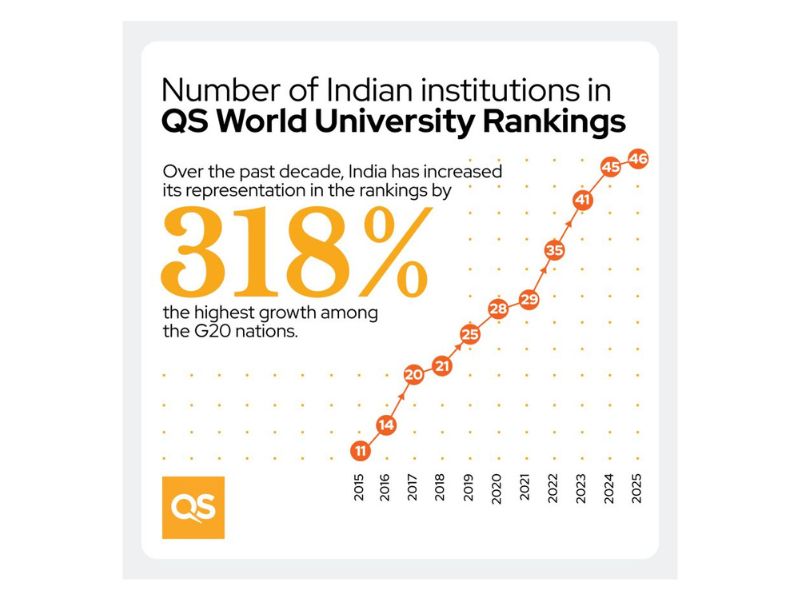In a landmark achievement, India has recorded the highest number of new entrants in the QS World University Rankings 2026, signalling an extraordinary 390% growth in ranked representation over the past decade. With 54 universities now included — up from just 11 in 2015 — India stands as the fourth most represented country globally, behind only the United States, the United Kingdom and Mainland China.
The latest rankings, released today by QS Quacquarelli Symonds, showcase India’s rapid rise in global higher education, especially in indicators such as Employer Reputation, Citations per Faculty, and Sustainability.
India’s Top Institutions: 2026 Rankings
| India Rank | Institution | Metropolitan Area | 2026 Rank | 2025 Rank | Change |
|---|---|---|---|---|---|
| 1 | Indian Institute of Technology Delhi (IITD) | New Delhi | =123 | =150 | +27 |
| 2 | Indian Institute of Technology Bombay (IITB) | Mumbai | 129 | 118 | -11 |
| 3 | Indian Institute of Technology Madras (IITM) | Chennai | 180 | =227 | +47 |
| 4 | Indian Institute of Technology Kharagpur (IITKGP) | Kharagpur | =215 | =222 | +7 |
| 5 | Indian Institute of Science (IISc) Bangalore | Bengaluru | =219 | 211 | -8 |
| 6 | Indian Institute of Technology Kanpur (IITK) | Kanpur | 222 | 263 | +41 |
| 7 | University of Delhi | New Delhi | =328 | =328 | 0 |
| 8 | Indian Institute of Technology Guwahati (IITG) | Guwahati | =334 | =344 | +10 |
| 9 | Indian Institute of Technology Roorkee (IITR) | Roorkee | =339 | 335 | -4 |
| 10 | Anna University | Chennai | =465 | 383 | -82 |
India’s Global Progress: At a Glance
- 390% increase in ranked universities over the last decade.
- 8 new entrants in 2026 — the highest among all countries.
- 48% of Indian universities improved their rank year-on-year.
- 5 institutions in the global top 100 for Employer Reputation.
- 8 institutions in the global top 100 for Citations per Faculty.
- India outperforms the UK, US, and Germany in average CpF score.
India Compared to Top Represented Countries
| Country | No. of Institutions | % with Higher Rank YoY | New Entrants |
|---|---|---|---|
| United States | 192 | 42% | 5 |
| United Kingdom | 90 | 27% | 1 |
| Mainland China | 72 | 45% | 1 |
| India | 54 | 48% | 8 |
| Germany | 48 | 54% | 0 |
Employer Reputation Scores
| Institution | Score | Global ER Rank | Change |
|---|---|---|---|
| IIT Bombay | 96.7 | 39 | +24 |
| IIT Delhi | 95.0 | 50 | +23 |
| Symbiosis International | 94.7 | 51 | -20 |
| IIT Madras | 85.8 | 87 | +40 |
| IIT Kanpur | 82.7 | 95 | +47 |
Citations per Faculty
| Institution | Score | Global CpF Rank | Change |
|---|---|---|---|
| IISc Bangalore | 99.9 | 15 | -4 |
| Anna University | 99.8 | 23 | -21 |
| IIT Kharagpur | 97.0 | 55 | +21 |
| IIT Guwahati | 96.9 | 56 | -14 |
| IIT Indore | 96.9 | 57 | -10 |
Challenges Identified
- International Students Ratio (5%):
78% of Indian universities saw a decline.
No Indian university is among the global top 500 in this indicator. - Faculty-Student Ratio (10%):
Only O. P. Jindal Global University made it into the top 350 globally (rank 257).
63% of Indian universities declined in this metric.
Global Competition Intensifies
The QS World University Rankings 2026 assessed over 1,500 universities across 106 countries. Key global developments:
-
MIT retains top spot for the 14th consecutive year.
-
Imperial College London climbs to 2nd.
-
China’s Fudan University enters global top 30.
-
Italy’s Politecnico di Milano enters the top 100 for the first time.
QS World University Rankings 2026 – Top 10 Global
| 2026 Rank | 2025 Rank | Institution | Country |
|---|---|---|---|
| 1 | 1 | Massachusetts Institute of Technology (MIT) | United States |
| 2 | 2 | Imperial College London | United Kingdom |
| 3 | 6 | Stanford University | United States |
| 4 | 3 | University of Oxford | United Kingdom |
| 5 | 4 | Harvard University | United States |
| 6 | 5 | University of Cambridge | United Kingdom |
| 7 | 7 | ETH Zurich | Switzerland |
| 8 | 8 | National University of Singapore (NUS) | Singapore |
| 9 | 9 | University College London (UCL) | United Kingdom |
| 10 | 10 | California Institute of Technology (Caltech) | United States |
India’s stellar performance in the QS World University Rankings 2026 marks a defining moment in its higher education journey. With substantial improvements across key indicators, the country is cementing its position as a major global academic player. However, to sustain this momentum, India must focus on improving international engagement, faculty recruitment, and student diversity — all essential to achieving its goal of becoming a global education powerhouse.
Also Read: QS Rankings are useless for undergrad education
Posted in National, News























